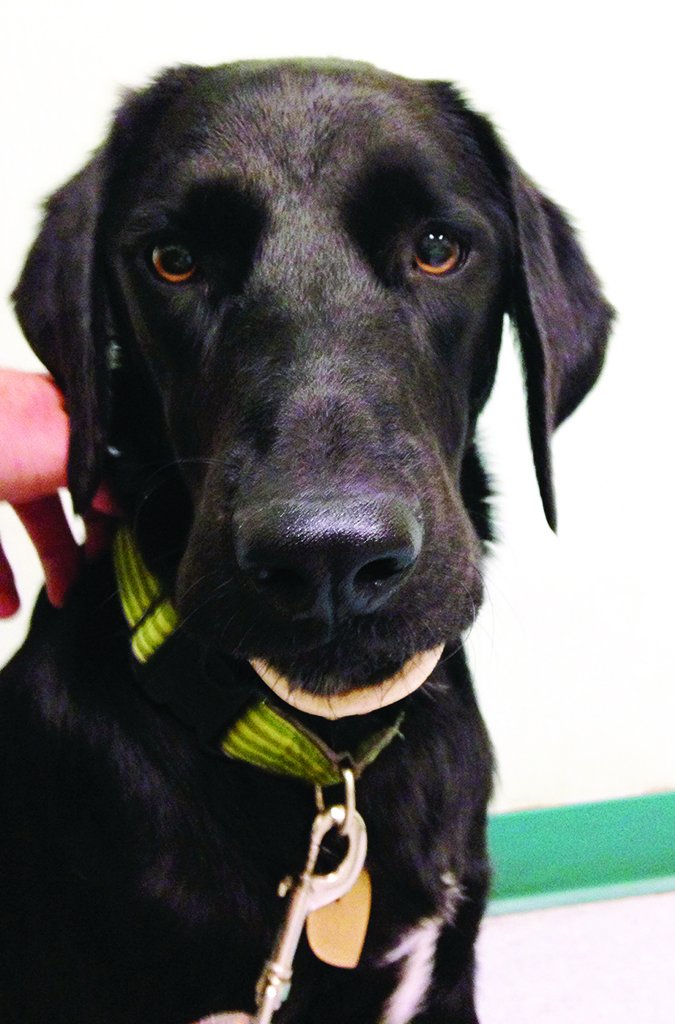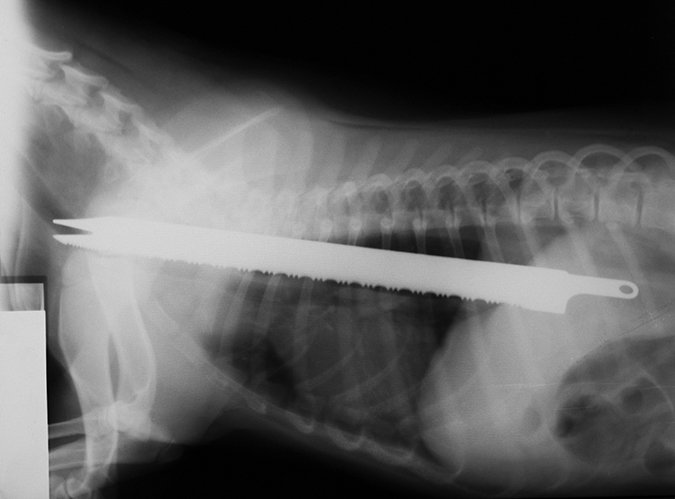Every year, thousands of dogs are treated in emergency veterinary hospitals across the country. I know; I spent nearly a decade as an emergency-room veterinarian. I always found it interesting that many of the most common injuries and illnesses I saw in emergency practice were also some of the easiest to prevent! Many of these problems can be avoided with a little common sense and preventative medicine.

Here, in no particular order, are a dozen simple tips to help you avoid a visit to the pet emergency room.
1. Keep your dog’s toenails trimmed.
As an emergency vet, I saw at least one torn toenail per shift. Bleeding toenails are not life-threatening, but they are extremely painful for the dog and can become infected.
Keep your dog’s nails short so that the tips do not snag. In some extreme cases, small breed dogs with long thick hair that obscures their feet will have toenails that have grown into the footpads. This is a painful condition and can lead to infection. Check your pet’s nails frequently! When in doubt as to whether they are too long, consult with your vet or groomer. (And read “Common Toenail Injuries on Dogs,” from this issue.)
2. Do not give your dog donut-shaped marrow bones.
Marrow bones can easily slip over the lower jaw of a dog and become lodged behind the canine teeth. While they go on with ease, it usually requires a trip to the emergency veterinarian to have them removed (often under sedation). Don’t believe me? Try a Google image search for “marrow bone dog jaw” – and don’t be surprised by how many photos you will find.
3. Keep fish hooks stored away from curious noses.
The smell of fish on a hook can often be too enticing for a dog. Even worse, the sight of a live, wriggling fish on the end of a fishing pole can drive a dog to unpredictable behavior. It is easy for a dog to grab or paw at a hook, but not so easy to dislodge it. Many hooks are trebled – possessing three barbs that must be cut and then pushed backward through the wound. This generally requires heavy sedation to accomplish, especially when stuck in a sensitive area such as the nose, tongue, mouth, or foot pad.
4. When driving, secure your dog with a well-fitted harness and dog seatbelt, or in a carrier that is firmly fastened in the car.
Do not let dogs stand in truck beds unsecured. Do not let them hang out of an open window. It is very common for a sudden turn to cause a dog to lose its balance and fall from the window or truck bed. In the event of an accident, a tethered or crated dog has less chance of injury, as well as causing injury to others in the car. Read more about car safety for dogs here.
5. Make sure that your yard is secure and that your dog has an identification microchip.
Hit-by-car injuries can be severe and deadly, as can fights with other dogs and wildlife. Always supervise your dog when he’s loose in the yard; dogs can be very adept at climbing over or digging under fences and underground fences (which are not recommended by Whole Dog Journal) don’t work for every dog. They also do not prevent other animals – domestic or wild – from wandering into your yard. It’s fast and easy to microchip your dog, and the chip will identify him if he gets loose for a quicker return to your home.
6. Recognize the common diseases that occur in your dog’s breed, so you can take appropriate action, fast.
For example: Brachycephalic breeds such as Bulldogs and Boxers often have upper-airway problems. They oxygenate poorly due to a combination of very short noses, small nostrils, and excessive tissue in the oropharynx (area of throat in the back of the mouth). This can lead to heat stroke. Heat stroke can happen to any dog if left in the wrong circumstances, but brachycephalic dogs are particularly prone to this. They can also overheat from simple excitement.
Need more examples? Geriatric Labradors are known to frequently suffer laryngeal paralysis, and as they age, this can become severe, leading to swollen upper airways and difficulty breathing. They produce a characteristic stridorous breathing – a high-pitched, wheezing sound.
Great Danes and other large-breed dogs are prone to a condition called “bloat” or gastric-dilatation and volvulus, the symptoms of which are discomfort, abdominal distention, salivating, and non-productive retching. This is a fatal condition if not treated with rapid recognition at home and emergency surgery.
Becoming familiar with the symptoms of these conditions can help you stop a crisis before it occurs. When in doubt, ask your vet for any breed-specific symptoms and preventative steps you should be aware of, such as prophylactic gastropexy for your giant-breed dog.
7. Keep medications secure.
Common household pain relievers like naproxen and ibuprofen can cause GI ulcers and kidney failure if ingested by your dog. Further, popular over-the-counter supplements such as 5-HTP, used in the treatment of a variety of disorders, can have severe consequences for pets. Ingestion of 5-HTP can lead to seizures, heat stroke, coma, and death.
8. If you have a puppy (or any dog who chews on random items) be sure to pick up small toys, socks, and underwear.
Many dogs love to chew and tear objects. Sometimes, they accidentally swallow them. Toys and clothing can cause obstruction of the GI tract requiring surgery to remove.
9. Don’t feed your dog fatty meats, fat cut from steaks, or fat from a roast poured from a broiler pan.
Pork, beef, and other fatty treats can cause pancreatitis, as well as significant GI upset including vomiting, diarrhea, abdominal pain, and loss of appetite. Cooked bones and inadequately chewed raw bones can cause obstruction of the GI tract, and in some cases, perforation of the GI tract. The signs of this may not manifest immediately, lulling you into a false sense of security about feeding these table foods.
10. Keep tasty treats well out of reach.
No- make that, keep anything edible out of reach! It’s tempting to believe that your dog can’t get on the counter, but if you spend five minutes on YouTube, you will rapidly realize how nimble our canine friends can be!
Of particular concern are rising bread dough, chocolate, grapes, raisins, and candy or gum that contains xylitol, a sugar substitute. These are all potentially lethal to your dog.
In addition to keeping your counters cleared of food, take care to keep meat skewers or knives that were used to prepare food out of reach. Dogs have been known to lick skewers ad knives, and have even swallowed them. Yes, dogs will swallow knives! (The x-ray below is from a real dog who swallowed a serrated bread knife! And lived, thanks to surgery to remove it.)
© Toxawww | Dreamstime.com

11. Closely supervise and manage any interaction between dogs who are unfamiliar with each other.
When introducing a new dog into the house (particularly small puppies), always closely monitor. Do not leave puppies unsupervised with adult dogs, as this can lead to unintentional injury. Even the best dog has a limit, and sometimes, older dogs will nip or snap. This can lead to head and mouth trauma.
12. Be careful with lawn and car products.
It’s very common for dogs who are outdoors frequently to come into contact with chemicals such as antifreeze, snail bait, and rat poison. Choose a pet-safe antifreeze (the main ingredient is propylene glycol). Avoid using slug and snail baits, as your dog’s exposure to these can cause tremors, seizures, and death.
If you choose to use a rat poison in your yard or house, make sure it is contained within dog-proof traps, and always make sure to keep the box (or ask the pest-control company for information on the type used) so that in the event of accidental ingestion, you know exactly what your pet consumed.
Compost piles present another common threat to dogs, as they can grow mycotoxins, a type of mold that when eaten leads to severe tremoring, high body temperature, and seizures. All compost piles should be fenced off from dogs.
Prevention is the Best Medicine
Most dog owners can attest that many canine emergencies happen at the most inopportune times – but it’s a good idea to cultivate a good relationship with your local general practice veterinarian in case of a daytime emergency. Keep the national pet poison control number (888-426-4435) posted prominently in your house and saved in your cell-phone contacts, too.
If you follow these steps with your dog, you will significantly decrease the chances of needing to visit the veterinary ER. With careful attention to health and your dog’s environment, you can keep your canine companion healthy and well for years to come.
Catherine Ashe graduated the University of Tennessee College of Veterinary Medicine in 2008. After a small-animal intensive emergency internship, she has practiced ER medicine for nine years. She is now working as a relief veterinarian in Asheville, North Carolina, and loves the GP side of medicine. In her spare time, she spends time with her family, reads voraciously, and enjoys the mountain lifestyle.






I would like to know how to avoid making a trip to an emergency vet. I like how you mention becoming familiar with the symptoms of your dog’s conditions so you can take action before something occurs. Thank you for the information. If something occurs to my dog I’ll contact a veterinary immediately.
I just recently bought a dog, and since I am a new pet owner, I’m quite clueless in regard to looking after a pet. I’m glad you shared this; I’ll make sure to keep the fish hooks stores away from my pet because as you’ve stated here the said hook might be stuck in his nose. Just in case this happens which I pray not to, I do hope that we will be able to find excellent veterinary service.
I always want the best care for my dog. Setting up an emergency plan would be a good idea. That way, I would know what to do if my dog was sick or hurt badly.